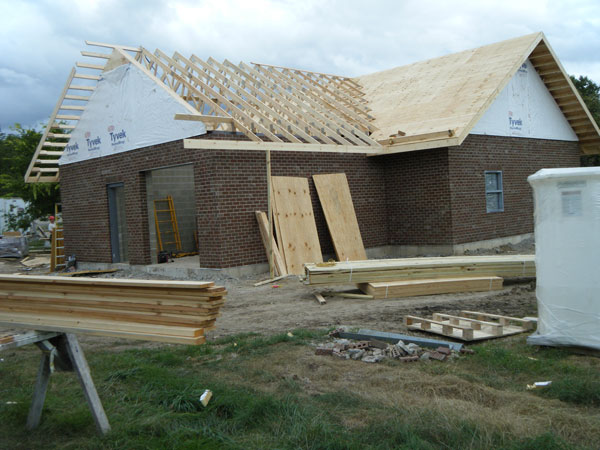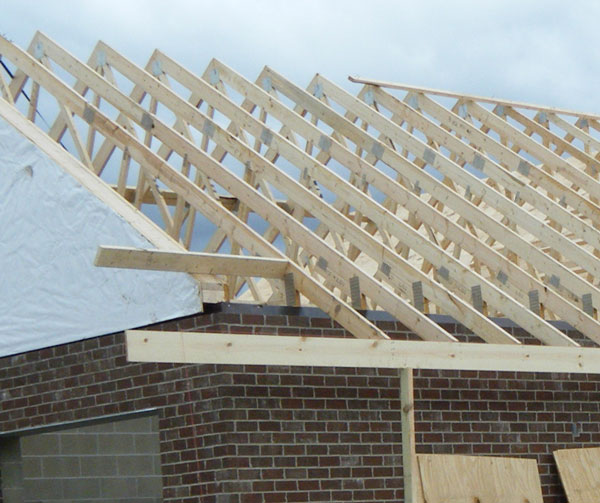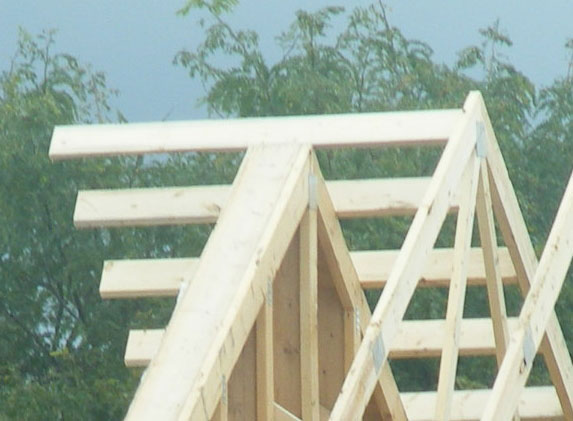Article and photos by Greg Havel
When firefighters think of a “roof,” we usually think of the uppermost part of the structure. We also usually think about it as a roof, not as an assembly of many parts and connectors, many or all of which are combustible or may be affected by age, deterioration, heat, and other stresses. This distinction becomes especially important to us if we are to be on the roof, or if the roof supports or roof sheathing are combustible and can serve as fuel for a fire in a concealed space.
Photo 1 shows a roof under construction on a Type III (ordinary) building in 2011. Wood plates have been anchored to the top of the masonry walls, and the wood trusses have been nailed to the plates. Temporary bracing supports the upper parts of the trusses until the roof sheathing is complete, as it has been at the right in the photo. The plywood sheathing braces the trusses and distributes loads between them, as they support the sheathing and roof covering.

(1)
The edges of the roof on all sides extend beyond the building walls, which carry its weight. A structural member or assembly that is unsupported on one side or one end is said to be a “cantilever.” The cantilevered parts of the roof are its least stable parts, whether the roof is of truss construction or of the more traditional methods using rafters.
It is common in roofs of any type of combustible construction, supported by either rafters or trusses, that the part of the roof that extends beyond the wall is supported by the “tail,” the cantilevered part of the rafter or truss (photo 2). These tails are usually (but not always) part of the rafter or truss extending beyond its bearing point. Sometimes the tail will be exposed when the building is finished; is also decorative; and is a separate piece of lumber connected to the end of the rafter or truss at its bearing point by nails, screws, or other fasteners.

(2)

(3)
It is also common in roofs supported by either rafters or trusses that the part of the roof that extends beyond the gable wall (photo 3) is supported by short, cantilevered pieces of lumber that bridge the top of the gable wall and are connected to the nearest rafter or truss (photos 2 and 3). These short cantilevers depend for stability on their connections to the top of wall and their connections to the nearby truss or rafter.
These cantilevered roof sections have in some instances collapsed beneath and fallen upon firefighters working at incidents. Never assume that they are as stable as the rest of the roof appears to be, since we probably will know neither the condition of the fasteners and connections, nor the condition of the structural members, nor the effects of fire in the concealed space upon both the connections and structural members.
Download this article as a PDF HERE.
 Gregory Havel is a member of the Town of Burlington (WI) Fire Department; retired deputy chief and training officer; and a 30-year veteran of the fire service. He is a Wisconsin-certified fire instructor II, fire officer II, and fire inspector; an adjunct instructor in fire service programs at Gateway Technical College; and safety director for Scherrer Construction Co., Inc. Havel has a bachelor’s degree from St. Norbert College; has more than 30 years of experience in facilities management and building construction; and has presented classes at FDIC.
Gregory Havel is a member of the Town of Burlington (WI) Fire Department; retired deputy chief and training officer; and a 30-year veteran of the fire service. He is a Wisconsin-certified fire instructor II, fire officer II, and fire inspector; an adjunct instructor in fire service programs at Gateway Technical College; and safety director for Scherrer Construction Co., Inc. Havel has a bachelor’s degree from St. Norbert College; has more than 30 years of experience in facilities management and building construction; and has presented classes at FDIC.
MORE CONSTRUCTION CONCERNS

